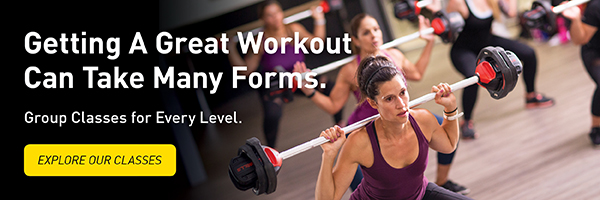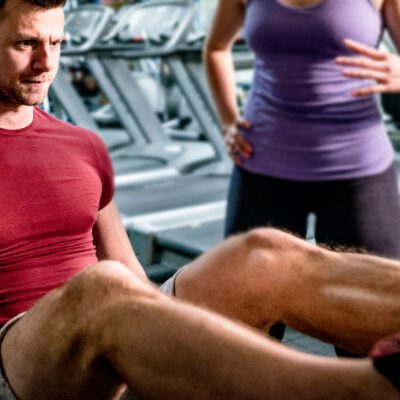Gym Safety: A Complete Guide
Are you pumped up to hit the gym more often? Whether inspired by the new year or just carpe-ing the diem, congratulations on your resolve. Knowing how to create a workout routine is one of the best things you can do for yourself.
Before you go full steam ahead on your fitness goals, however, it’s important to know how to do so safely. Exercising improperly or not using gym equipment correctly can not only get in the way of the results you’re hoping for, but can also result in injury. On the other hand, knowing proper habits and techniques can help to keep you safe from harm and optimize your workout for even better outcomes.
Whether you’re looking to start exercising at a fitness center or already have some experience under your (lifting) belt, we’ll discuss some gym safety tips that can help to ensure your fitness regimen is all gain, no pain.
Prepare Before You Get to the Gym
Gym safety starts well before you ever pick up a barbell. It starts even before you walk in the door! Follow these steps to make sure you’re in good shape to get in shape.
Talk to Your Doctor
An annual health checkup from a physician is recommended for everyone, and can reveal conditions that could affect your exercise ambitions.
And while it’s not mandatory to consult with a doctor about your fitness plans if you’re in good health, you absolutely should if you:1
- Haven’t been active in a long time
- Have high blood pressure
- Have diabetes
- Have heart disease
- Have asthma
- Have osteoporosis or another bone or joint disease
- Have a neurological illness
- Have another preexisting condition
- Are pregnant
- Smoke
- Are on medication
If you have these or any other unaddressed health symptoms, it’s wise to consult your physician before starting a new workout routine—especially a rigorous one.
Acquire the Proper Equipment
You should use proper equipment in good condition designed for the sport or activity you intend to take up. This includes:2
- Well-fitting shoes that you replace every 6 months, or as they wear out
- Comfortable, light, loose clothes that breathe, especially in hot weather
- Easily-removable layers for cold weather
- Whatever protective gear is recommended for your sport, including mouthguards, shin pads, and helmets
Find a Gym Buddy
Some people prefer to exercise by themselves, but in addition to extra encouragement to stick to the program, working out with a friend can improve gym safety by providing:3
- An extra set of eyes to watch out for environmental hazards
- Feedback to achieve proper form
- Encouragement to drink and breathe
- A spotter for weight lifting
Follow Gym Etiquette (And Help to Prevent Hazards)
Being aware of yourself and others can go a long way toward gym safety before you ever set foot on a treadmill. Following these gym etiquette practices can prevent injuries for yourself and others:4
- Be mindful of your surroundings—noticing who is nearby, and what they are doing—and give people the space they need.
- Make sure your shoelaces are tied and your long hair is put up.5
- Scan for trip hazards before you work out, and pick up your towel, water bottle, or any other items from the gym floor before you move on to another part of the gym.
- Wipe up any water you may have spilled or excessive sweat from the gym floor.
- Wipe your sweat off any fitness equipment after you use it.
- Don’t exercise in the sauna or steam room. It’s annoying to others and could be harmful to you.4
Warm Up, Stretch, and Cool Down
There’s some debate as to whether warming up and stretching before a workout and cooling down afterward actually prevent injuries, but it is still recommended. It may reduce soreness and, at the very least, can prepare your body to move and help you focus on your workout.
Warm Up
The first part of your workout, even before you stretch, should be to warm up.5 There are many benefits of warming up before a workout. Not only does it get your blood flowing, but it also prepares your joints and muscles for the more intense physical activity to come.
Warming up doesn’t need to last long—it can be as short as 3 to 5 minutes, and can include light exercises like:
- Walking in place or on a treadmill
- Running or lightly jogging in place or on a treadmill
- Using an elliptical or stationary cycle at a relaxed pace with minimal exertion before you try for your target level
- Rehearsing the movements in the exercises you intend to do to signal those muscle groups that it’s time to engage
- Ten pushups, ten knee lifts, and ten squats
Stretch
Stretching at least twice a week can help you to increase your flexibility and range of motion, which can lead to a safer workout.5 Stretch after you warm up and follow these guidelines:
- Move slowly and deliberately, with control, into and out of a stretch. Don’t make jerky movements.
- Hold the stretch for 10 to 30 seconds.
- Don’t bounce into a stretch. Over-stretching makes muscles contract, and pushing them further can tear the muscle tissue. If you feel pain, release the stretch.
Cool Down
Cooling down is the last step of your workout, and helps you to bring your temperature and heart rate slowly back to baseline. You can cool down by simply reducing the speed, intensity, or weight of your workout for 3 to 10 minutes before you come to a complete stop.5
Use Equipment Correctly
A gym is full of fitness equipment with heavy, fast-moving parts that can injure your fingers, toes, and other body parts. Many have easy-to-read visual instructions. Familiarize yourself with their operation before you use them, and ask gym staff for help if you need it.
Here are some safety tips to keep in mind for common gym equipment:
Bench Press
Though it’s one of the simplest pieces of exercise equipment, with hundreds of pounds of free weight getting thrust into the air over your body, the bench press is also one of the most dangerous. Follow these tips to use one safely:6
- Recruit someone to spot for you.
- Make sure the collars (the clips that keep the weight plates in place) are used correctly.
- Keep your feet on the ground.
- Hold your chest out and your shoulder blades back.
- Keep a firm grip on the bar.
- Look straight ahead at the ceiling.
- Don’t use your chest to stop or bounce the bar on the way down.
- Return the bar and plates to their proper places when done.
Pulley Machines
Pulley machines are safer than free weights, but can still have their own hazards. Follow these tips to help prevent injury:6
- Learn each machine’s operation before using it.
- Check for wear and tear on the cables.
- Set the machine’s positions in accordance with your exercise targets.
- Make sure the pins are used correctly.
Rowing Machines
Likewise, a rowing machine should be used properly to ensure safety. Follow these tips to safely operate rowing machines:6
- Check the stability of the machine before you start.
- Secure your feet tightly in the straps.
- Point your toes up, not curled in or out.
- Keep your back straight and be sure not to arch.
- Keep the handle parallel to the floor and don’t twist or turn it.
If you are using this machine for the first time, check out these row machine workouts for beginners to make sure you are using this piece of equipment accurately and efficiently.
Other Equipment
Some gym equipment is more self-explanatory, but still needs to be used with respect and care. Examples include:6
- Stationary bike – Check that you and the bike are the right fit for each other, adjusting the seat and handlebars as needed. Wait until the pedals stop completely before you dismount the bike.
- Ab-crunch – Keep your arms bent at 90 degrees. Start light and move with the same control you would for lifting weights.
- Elliptical – Maintain an upright position and don’t lean forward over the bars. Confirm that your lower body is supporting your whole weight. Wait until the machine comes to a complete stop before stepping off.
Practice General Workout Safety
There are a few general principles you can bring to any type of workout that will improve the safety and efficacy of your performance.
- Be patient – Despite what you might have heard, go hard or go home does not always apply to the gym. Finding a balance between what challenges you and what’s safe for your body is essential to preventing injury. Build up gradually in intensity, frequency, and duration, but never all at the same time.
- Listen to your body – Working out can be strenuous, and you should expect (and may even come to enjoy) a little soreness a day or two after exercise. But it shouldn’t be painful. Be kind to yourself and acknowledge your limitations. If you experience pain during your workout, stop. If you are tired all the time, you may be working out too often.
- Learn proper techniques – Proper form can boost your performance and keep you safer. Techniques can include everything from proper posture to making sure you breathe in between reps. If you’re not sure what the proper technique is for the exercise you’re performing, ask gym staff or a regular to help you out with a form check.
- Seek help when you need it – We all start somewhere. Don’t be afraid to ask for advice when you’re not sure what you’re doing. A personal trainer can help make sure that you move correctly and in a way that won’t strain your lower back or other problem areas, but the price point can be a non-starter. Consider fitness classes or team training if you want to break your record but not break the bank.
- Diversify – Develop a balanced program that includes cardio, strength, and flexibility, and vary your workouts to prevent overuse injuries. This also keeps you mentally engaged so you don’t lose concentration.
- Hydrate – We lose 1.5L of fluid per hour of exercise.7 To prevent dehydration, heat exhaustion, and heat stroke, drink 1 pint of water fifteen minutes before you start, half a cup every 15 to 20 minutes during, and another pint after you cool down.
- Rest – Some exercise is better than none, but working out more than five days a week can lead to diminishing returns. Give yourself one or two days off to recover and rest when you’re tired.
Chuze Fitness: A Safe Flex
With these safety tips in mind, you can confidently start or resume your fitness journey with a safer and more efficient gym experience. But when it comes to working out safely and getting help when you need it, it also helps to have a gym community that has your back.
At Chuze Fitness, our mission is to build healthier communities through human connections and kindness. That starts with self-kindness and extends to our gyms being a welcoming place where you’ll feel like you belong and never pressured to push yourself too hard.
It also extends to our astonishingly low price point. Because we believe that we all deserve great results when we search for “gyms near me.”




Ani is the Vice President of Fitness at Chuze Fitness and oversees the group fitness and team training departments. She’s had a 25+ year career in club management, personal training, group exercise and instructor training. Ani lives with her husband and son in San Diego, CA and loves hot yoga, snowboarding and all things wellness.
Sources:
- Mayo Clinic. Exercise: When to check with your doctor first. https://www.mayoclinic.org/healthy-lifestyle/fitness/in-depth/exercise/art-20047414
- OrthoInfo. Safe Exercise. https://orthoinfo.aaos.org/en/staying-healthy/safe-exercise/
- Verywell Fit. 7 Gym Safety Tips for Healthy Workouts. https://www.verywellfit.com/gym-safety-tips-3435211
- Healthline. Know the Code: Gym Etiquette for Every Situation. https://www.healthline.com/health/fitness/gym-etiquette#in-group-fitness
- MedlinePlus. How to avoid exercise injuries. https://medlineplus.gov/ency/patientinstructions/000859.htm
- SF Healthtech. Exercise Safety Checklist: How to Use Gym Equipment Safely. https://sfhealthtech.com/blogs/post/exercise-safety-checklist
- Better Health Channel. Exercise safety. https://www.betterhealth.vic.gov.au/health/healthyliving/exercise-safety
- Harvard Health Publishing. 10 tips for exercising safely. https://www.health.harvard.edu/healthbeat/10-tips-for-exercising-safely
- USA Today. Working Out From Home: Safety tips from athletic trainers for exercising while staying home. https://www.usatoday.com/story/sports/2020/03/30/coronavirus-athletic-trainers-advice-workout-safely-from-home/2937439001/
- Kaiser Permanente. 6 tips to keep moving and avoid injury. https://wa-health.kaiserpermanente.org/6-tips-keep-moving-avoid-injury/






